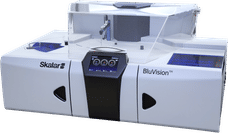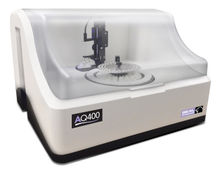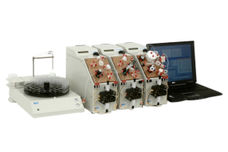Making a better nitrate test kit
Advertisement
The dull black plastic of the device on Joshua Pearce's desk belies its usefulness. Pearce picks up the box, which has a switch on the side and a small opening on top. A handful of vials sit in a bag nearby, and each would fit snugly in the opening. The set-up seems generic, even bland, except that it could radically change how we deal with water quality issues.

Monitoring nitrate is one of today's biggest water quality challenges. Michigan Tech professor Joshua Pearce and the Nitrate Elimination Company are looking to make this process better.
NECi
Pearce, who has a joint appointment as an associate professor of materials science and engineering as well as electrical and computer engineering, runs an open sustainability technology lab at Michigan Technological University. Along with his students, Pearce made a handheld device with a 3-D printer and open source hardware in collaboration with the Nitrate Elimination Company, Inc. (NECi). The small machine replaces comparable devices that cost more and rely on old methods based on cadmium or zinc. The idea is to create better tools for testing nitrate content in water and soils.
"The beauty of this device is that it's extremely adaptable, more sensitive, safer and smaller," Pearce says. "We have both the 'business story' and the 'feed the people story' here."
Nitrate and Water Quality
High nitrate levels in water cause the dead zones in the world's largest deltas. Using too much nitrogen fertilizer wastes resources and leads to nitrate in runoff and water wells and an excess of nitrate in drinking water is a health hazard to infants and harmful to many animals. Current portable nitrate testers range in price and accuracy, from ballpark data at low price points to several hundred dollars for a handheld photometer. This new design is palm-sized, interfaces with a free Android app, costs less than $65 to manufacture and uses green chemistry for a safer and more accurate testing procedure.
"This is a Popeye-approved reagent methodology," Pearce jokes, adding that the enzyme used in the test kit is found in spinach and other leafy greens. "We're replacing a toxic heavy metal with something that you eat every day in your salad."
Kale and collards aside, Pearce is serious about how the enzyme, called nitrate reductase, makes for a better device since NECi considers the chemical processing from sourcing to disposal. Pearce says, the device not only works, it "performs as well as commercial proprietary systems for less than 15 percent of the cost for materials and is 100 percent open source."
Having freely available hardware and software is only part of what makes this new nitrate test kit an improvement in the industry.
Making a Better Test Kit
Ellen Campbell, the CEO of NECi, hopes to revolutionize standard nitrate testing – as well as phosphate testing and other procedures - so that everyone has access to more affordable and more sensitive equipment. NECi's nitrate test reagents are close to being standardized by the Environmental Protection Agency for use under the Clean Water Act. The US Geological Survey embraced the reagents in their labs.
Original publication
Other news from the department science
These products might interest you
Most read news
More news from our other portals
See the theme worlds for related content
Topic world Photometry
Photometry, the measurement of light intensity in relation to interaction with molecules, is a key tool in chemistry and life sciences. It enables researchers to determine concentrations of substances in solutions, follow reaction kinetics or check the quality of samples and provides valuable data for analyses, from quality control in the laboratory to clinical diagnostics.

Topic world Photometry
Photometry, the measurement of light intensity in relation to interaction with molecules, is a key tool in chemistry and life sciences. It enables researchers to determine concentrations of substances in solutions, follow reaction kinetics or check the quality of samples and provides valuable data for analyses, from quality control in the laboratory to clinical diagnostics.






























































